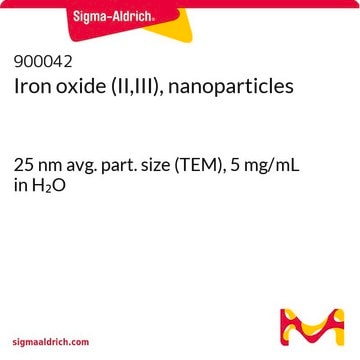720704
Iron(III) oxide, dispersion
nanoparticles, ≤110 nm particle size, 20 wt. % in H2O
Synonym(s):
Iron oxide in water
Sign Into View Organizational & Contract Pricing
All Photos(1)
About This Item
Empirical Formula (Hill Notation):
Fe2O3
CAS Number:
Molecular Weight:
159.69
MDL number:
UNSPSC Code:
12352300
PubChem Substance ID:
NACRES:
NA.23
Recommended Products
form
nanoparticles
Quality Level
concentration
20 wt. % in H2O
particle size
≤110 nm
pH
6-8
density
1.17 g/mL±0.1 g/mL at 25 °C
SMILES string
O=[Fe]O[Fe]=O
InChI
1S/2Fe.3O
InChI key
JEIPFZHSYJVQDO-UHFFFAOYSA-N
Looking for similar products? Visit Product Comparison Guide
Storage Class Code
10 - Combustible liquids
WGK
nwg
Flash Point(F)
Not applicable
Flash Point(C)
Not applicable
Choose from one of the most recent versions:
Already Own This Product?
Find documentation for the products that you have recently purchased in the Document Library.
Customers Also Viewed
Magnetic iron oxide nanoparticles: synthesis, stabilization, vectorization, physicochemical characterizations, and biological applications
Laurent S, et al.
Chemical Reviews, 108(6), 2064-2110 (2008)
J Sangeetha et al.
Journal of biomedical nanotechnology, 9(5), 751-764 (2013-06-28)
We present methodologies to functionalize iron oxide (Fe3O4) nanoparticles with biosurfactants and biocompatibility results. Positively charged Fe3O4 nanoparticles of average hydrodynamic size -26 nm is functionalized with four different molecules of interest, viz., surfactin, rhamnolipid, polyethylene glycol (PEG) and dextran.
Alice Panariti et al.
Journal of biomedical nanotechnology, 9(9), 1556-1569 (2013-08-29)
Magnetic nanoparticles have emerged as important players in current research in modern medicine since they can be used in medicine for diagnosis and/or therapeutic treatment of diseases. Among many therapeutic applications of iron-based nanoparticles, drug delivery and photothermal therapy are
Andrew Pratt et al.
Nature materials, 13(1), 26-30 (2013-11-05)
Geometry and confinement effects at the nanoscale can result in substantial modifications to a material's properties with significant consequences in terms of chemical reactivity, biocompatibility and toxicity. Although benefiting applications across a diverse array of environmental and technological settings, the
Rajenahally V Jagadeesh et al.
Science (New York, N.Y.), 342(6162), 1073-1076 (2013-11-30)
Production of anilines--key intermediates for the fine chemical, agrochemical, and pharmaceutical industries--relies on precious metal catalysts that selectively hydrogenate aryl nitro groups in the presence of other easily reducible functionalities. Herein, we report convenient and stable iron oxide (Fe2O3)-based catalysts
Our team of scientists has experience in all areas of research including Life Science, Material Science, Chemical Synthesis, Chromatography, Analytical and many others.
Contact Technical Service



